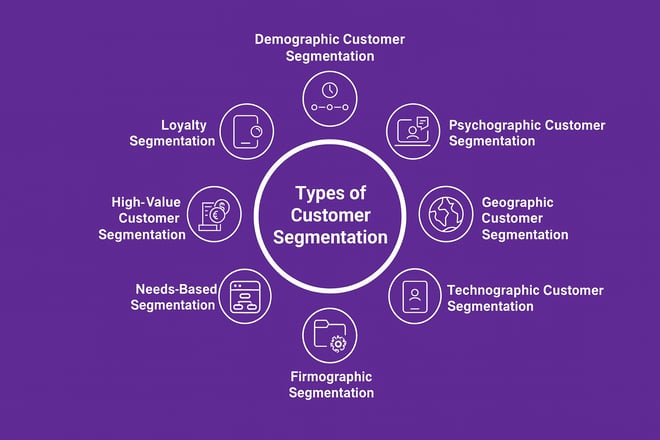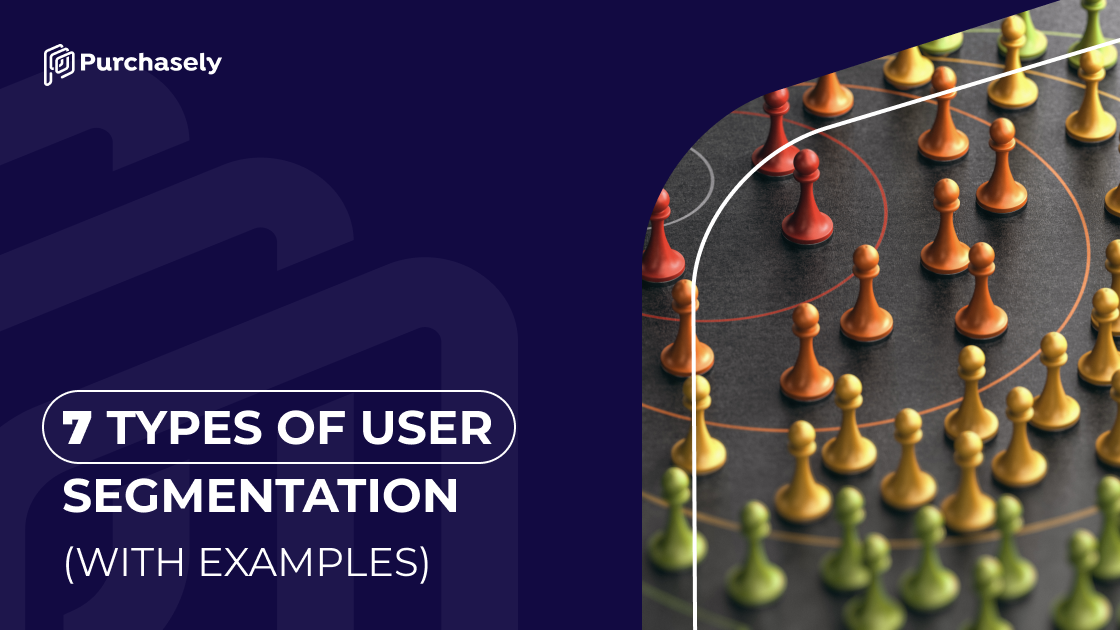Want to up your user segmentation game? We’ve got you covered. In this guide, we’ll explore the 7 most effective types of user segmentation with examples.
To make a great mobile app, you need to know your users inside and out.
One way to do this is through user segmentation, where you group users based on shared characteristics like age, interests, and behavior. By doing this, you'll get a better understanding of what each group wants from your app, which can have lots of positive effects such as:
-
Increase email campaign open and click-through rates (Mailchimp)
-
A higher return on promoted sales (McKinsey)
-
Identify best-fit customers (Royal Mint)
-
Break into new markets
-
Reduce customer acquisition costs
It's like putting on different glasses to see your users more clearly - you can get a closer look at what makes them tick and what they need from your app.
In this guide, we’ll break down seven proven segmentation models—with real-world examples—to show how today’s top apps turn data into smarter decisions and stronger results.
Table of contents
-
What is user segmentation and why it matters
-
7 common user segmentation models
-
How to build a user segmentation strategy
-
Purchasely’s role in segmentation-driven growth
-
Final thoughts
What is user segmentation and why it matters
Imagine two users open your app at the same time. One is a new college student browsing on a budget. The other is a longtime subscriber who always buys premium features.
If you treat them the same, you’re missing a big opportunity. That’s where user segmentation comes in.
User segmentation means grouping users into smaller segments based on shared characteristics — like behavior, location, or preferences — so you can better understand what they need and how to reach them. Instead of designing for a crowd, you speak directly to each user segment.
Here’s why segmentation matters for growing your app today:
-
Faster time-to-value: Segmenting users helps you match the right features or messages to the right people earlier in the journey.
-
Higher retention: Users who feel understood are more likely to stay. Behavioral segmentation can reveal churn risks before it’s too late.
-
Smarter product decisions: Segment-level data shows what’s working and where to improve user experience based on real product usage.
-
Better ROI across channels: From in-app messages to CRM and ads, segmenting customers leads to more relevant, higher-converting campaigns.
-
More personalized experiences: Customer segmentation turns a generic app flow into one that adapts to each user’s goals, habits, and intent.
The better you understand each user segment, the better you can serve them.

7 most common user segmentation models
There’s no one-size-fits-all way to segment users.
The right segmentation model depends on your app, your goals, and the type of customer data you can access. That said, some models show up again and again in the most effective segmentation strategies. Why? Because they work.
These seven types of user segmentation help leading apps tailor the user experience, uncover high-value segments, and make smarter product and marketing decisions at every stage of the customer journey.
Let’s break them down, starting with the most familiar: demographic segmentation.
1. Demographic segmentation
Demographic segmentation is one of the most straightforward ways to segment users. It involves grouping people based on shared characteristics like age, gender, income, education level, or occupation. While simple, it’s often the starting point for more advanced customer segmentation models — especially when combined with behavioral or psychographic data.
This segmentation model works best when demographic traits strongly influence product usage or purchase intent. For mobile apps, it can guide everything from feature access to paywall messaging and CRM workflows.
Example: A wellness app finds that users aged 18–24 engage more with daily challenges, while users over 40 prefer long-form meditation content.
By segmenting users by age and gender, the team tailors onboarding flows, notification timing, and subscription offers. This leads to higher engagement and a better customer experience for each user group.
Demographic segmentation may seem basic, but when layered with richer data, it becomes a powerful tool to personalize experiences at scale.
2. Geographic segmentation
Geographic segmentation means grouping users based on where they are — by country, region, city, or even climate zone. While it may sound like simple market segmentation, location often affects language, culture, habits, and expectations, all of which impact user behavior and product usage.
For mobile apps with global reach, this segmentation model is key to delivering relevant experiences. It helps teams localize content, adjust pricing, optimize delivery or availability, and customize promotions based on local trends.
Example: A food delivery app sees that users in southern France prefer local cuisine and dine later in the evening, while users in Berlin favor faster meals and order earlier.
By segmenting users by region and city, the app adjusts restaurant recommendations, delivery hours, and in-app offers — leading to higher conversion rates and more repeat orders.
Geographic segmentation turns broad audiences into distinct groups with tailored journeys, helping you meet customer needs with local precision.
3. Psychographic segmentation
Psychographic segmentation groups users based on internal factors — things like values, lifestyle, interests, personality, or motivation. Unlike demographic segmentation, which focuses on who someone is, psychographic segmentation explores why they behave the way they do.
This model is especially useful for apps tied to identity, habit, or emotion — like fitness, learning, wellness, or finance. It helps teams build stronger connections by speaking to what users care about.
Example: A running app segments users by motivation. One group trains for races and wants performance data. Another runs for mental health and values encouragement.
By tailoring content, push notifications, and challenges to each user segment, the app sees deeper engagement and stronger retention.
Psychographic segmentation adds emotional intelligence to your strategy — helping you move beyond surface traits and speak directly to user intent.
4. Behavioral segmentation
Behavioral segmentation focuses on what users actually do — their habits, actions, and usage patterns inside your app. It’s one of the most valuable segmentation models because it’s based on real behavior, not assumptions.
You can segment users by how often they log in, which features they use, how they respond to offers, or where they drop off in the funnel. Unlike demographic or geographic segmentation, this model gives you a live view of user engagement and intent.
Example: A language learning app identifies three key user segments: daily learners, casual users, and churn-risk users who haven’t opened the app in five days.
Each group gets a different experience — streak rewards, gentle nudges, or reactivation offers. By segmenting users based on actual product usage, the app improves retention and boosts conversion from free to paid.
Behavioral segmentation gives teams the clearest picture of what drives user behavior and how to act on it.
5. Firmographic segmentation
Firmographic segmentation applies the logic of demographic segmentation to businesses instead of individuals. It’s essential for B2B apps or platforms serving teams, where the customer is a company, not just a single user.
You can segment users based on company size, industry, revenue, location, or team structure. These firmographic traits often influence product needs, pricing sensitivity, and the level of customer service required.
Example: A project management app segments its user base into startups, mid-sized companies, and enterprise clients.
Each customer segment gets a tailored experience — startups receive lightweight tools and self-serve support, while enterprise teams get advanced features, compliance add-ons, and dedicated account managers. This segmentation strategy leads to higher satisfaction and better upsell performance.
Firmographic segmentation helps you align your product and pricing with the real needs of each business — turning broad usage into targeted value.
6. Technographic segmentation
Technographic segmentation groups users based on the technology they use — including device type, operating system, browser, app version, or connectivity. For mobile-first companies, it’s essential to understand how users interact with the product across different platforms.
This segmentation model helps teams design better user experiences, prioritize feature development, and target technical upgrades or promotions more effectively.
Example: A video editing app segments its user base by device. Mobile users get a simplified interface with gesture controls and limited export options, while desktop users access multi-track editing and advanced tools.
The app also identifies Android users with outdated versions and prompts them to update for better performance.
By segmenting users by their tech setup, teams can improve usability, reduce churn, and ensure each customer segment gets the right experience — no matter the platform.
7. Transactional segmentation
Transactional segmentation focuses on how users spend, including purchase history, frequency, amount, and recency. It’s a subset of behavioral segmentation, but with a sharper focus on monetization and customer lifetime value.
By segmenting customers based on their transactional data, you can identify high-value segments, create personalized offers, and run smarter upsell or win-back campaigns.
Example: An e-commerce app identifies users who’ve made multiple high-value purchases in the last 60 days. These customers get early access to product drops and exclusive loyalty perks.
Meanwhile, first-time buyers are nudged with onboarding content and limited-time discounts. This approach helps increase retention and revenue across different segments of the user base.
Transactional segmentation gives you a clear view of where your revenue is coming from — and how to grow it with the right strategy for each customer segment.
How to build a user segmentation strategy
Choosing the right segmentation model is only part of the equation. To make user segmentation truly work, you need a clear plan — one that connects your customer data to real outcomes across product, marketing, and growth.
The steps below outline how high-performing teams build and scale effective segmentation strategies that improve user experience and drive revenue.
Define clear business goals
Before segmenting users, define what success looks like. Are you trying to increase conversions, reduce churn, improve onboarding, or grow revenue from a specific customer segment? Your goals will guide which segmentation model to use — and how to measure impact.
For example, if your goal is to improve retention, behavioral segmentation may help you identify where users drop off. If you're focused on monetization, transactional segmentation could reveal high-value segments to target with personalized offers.
Clear goals turn segmentation from a data exercise into a growth strategy with focus and direction.
Tip: Keep goals specific and measurable. “Increase user engagement” is vague — “increase D7 retention by 10% in our Gen Z segment” gives you something to work toward and test against.
Gather and unify your user data
Once your goals are clear, the next step is to collect the customer data that powers segmentation. Strong segmentation depends on having the right signals — and making sure they’re connected across your tools.
Start by identifying all the data sources tied to your user base:
-
In-app analytics (like product usage, session length, feature adoption)
-
CRM and CDP platforms (to connect behavioral and demographic data)
-
Google Analytics and web activity (for cross-platform tracking)
-
Customer surveys and feedback forms (to enrich with preferences and motivations)
-
Transactional data from your billing or payments provider
Combining these sources helps build a complete view of each user — not just who they are, but what they do and what they care about.
Tip: Don’t wait for perfect data. Start with what you have, then layer in more as your segmentation strategy evolves.
Identify your key user segments
With your data in place, it’s time to define the user segments that matter most for your goals. You don’t need dozens — just the ones that help you act.
Start with relevance over reach. Instead of slicing your user base into every possible group, focus on the segments that directly impact growth. If your goal is retention, look at user behavior: Are there patterns among those who stay vs. those who churn? If your goal is expansion, segment users by product usage to identify power users or high-LTV customers.
Use segmentation models that align with your app’s core experience:
• Firmographic or technographic segmentation if you serve teams or cross-platform users
Tip: Strong user segments are easy to describe, easy to reach, and easy to act on. If you can’t tailor something meaningful to them, they may not be worth segmenting.
Prioritize by value and impact
Not all user segments are created equal. Some will be large but low impact. Others — like high-value subscribers or early churn risks — may be small but critical to your growth.
Start by ranking segments based on:
-
Size — How many users fall into this segment?
-
Business value — Do they contribute meaningful revenue or engagement?
-
Strategic fit — Do they align with your goals (e.g. launching a new feature, growing ARPU, reducing CAC)?
• Ease of activation — Can you reach them effectively across channels?
This helps you focus on the customer segments that offer the best return on effort — and prevents teams from chasing segments that are interesting but not actionable.
Tip: Overlay metrics like lifetime value or churn rate on each user segment to see where you can move the needle fastest.
Design and launch personalized strategies
Now that your segments are defined and prioritized, it’s time to put them to work. Use each user segment to tailor how you communicate, what you offer, and when you engage.
Personalization doesn’t mean overcomplication. A few small changes — like adjusting tone, feature focus, or timing — can lead to big improvements in user engagement and retention.
For example:
-
Behavioral segmentation for lifecycle targeting
-
Psychographic segmentation for motivation-driven UX
-
Firmographic or technographic segmentation if you serve teams or cross-platform users
-
Segmenting users by onboarding behavior can trigger custom tutorials or reminders
-
Using transactional segmentation can power VIP offers or loyalty pricing
-
Segmenting customers by geography can shape time-sensitive promotions or local content
-
Technographic segmentation helps refine UX by platform — like simplifying flows on mobile
Use these insights across your lifecycle — from onboarding to upsell to win-back. The more your app adapts to the customer, the more likely they are to stick around.
Tip: Start with one segment and one channel — then test, measure, and expand. Precision beats scale when it comes to effective segmentation.
Purchasely’s role in segmentation-driven growth
A great segmentation strategy is only as strong as your ability to act on it. That’s where Purchasely comes in.
With Purchasely, teams can easily segment users based on subscription status, user behavior, customer data, preferences, and more — all without writing custom code.
Whether you're running experiments or refining your customer segmentation model, Purchasely makes it easy to deliver personalized experiences across the entire funnel.
.png?width=2146&height=1614&name=PFE%20landing%20page%20header%20(1).png)
Using Target Audience, you can:
-
Segment users by onboarding progress, paywall interactions, or subscription intent
-
Customize in-app flows by location, device, language, or app version (via technographic and geographic segmentation)
• Create lifecycle campaigns for win-back, upgrade, and churn-prevention — all tailored to specific customer segments
With these customized attributes, you can program your entire funnel campaigns — from onboarding to win-back — pre-setting your efforts to fortify the funnel and prevent churns before they occur.
Final thoughts
User segmentation isn’t about slicing your audience into smaller pieces — it’s about understanding people better, so you can serve them smarter.
The best teams treat segmentation as an ongoing process, not a one-time setup. With the right data, tools, and strategy in place, segmentation becomes the foundation for more relevant messaging, smarter product decisions, and higher-performing campaigns.
New to Purchasely?
Purchasely is the app experience platform built to help mobile teams turn segmentation into growth. Use Purchasely to design targeted paywalls, in-app journeys, and personalized offers — all powered by deep customer data and easy-to-use tools. Book a product tour today and see how segmentation can drive real results.



.png?width=2146&height=1614&name=PFE%20landing%20page%20header%20(1).png)



